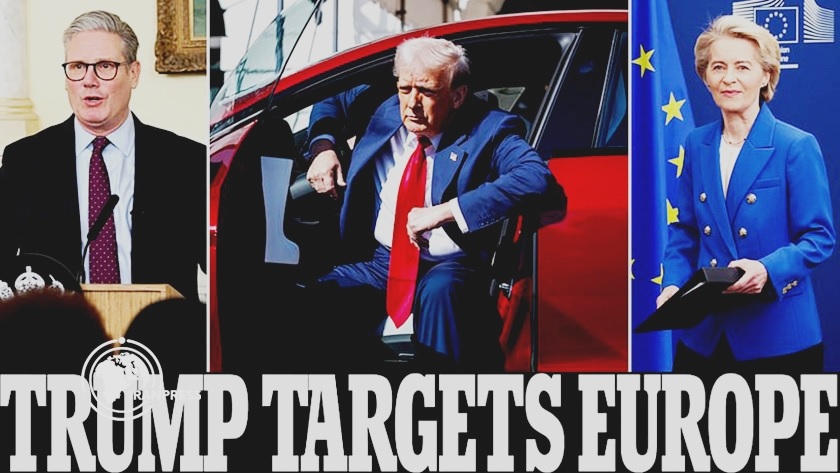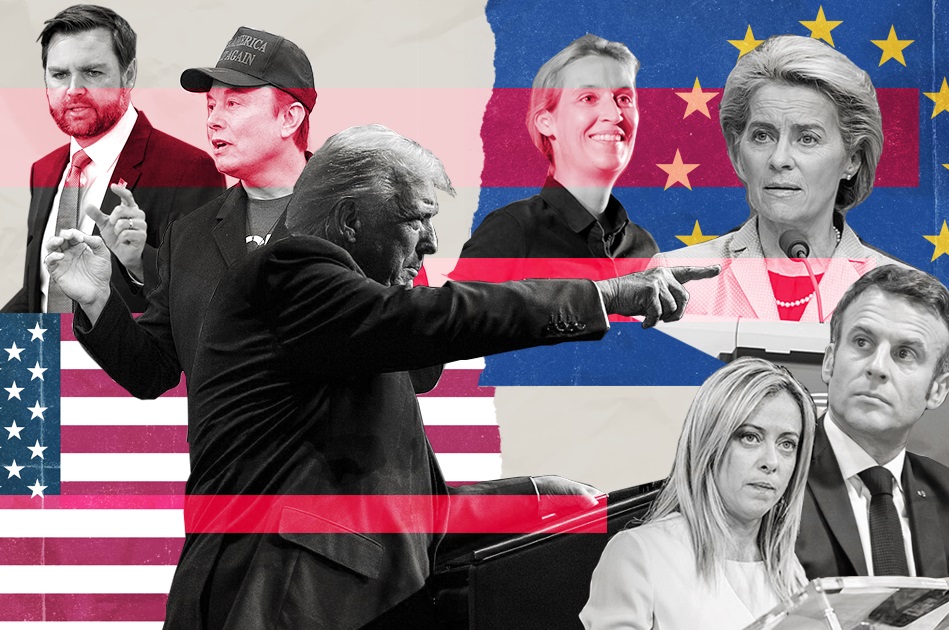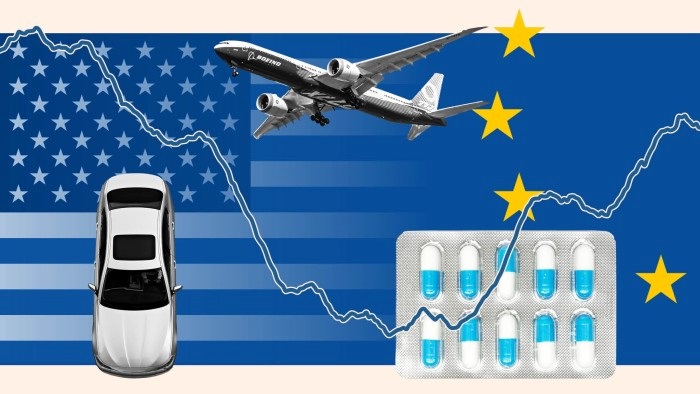 Pic.: Iran Press
Pic.: Iran Press
President Donald Trump on Friday threatened a 50% tariff on goods from the European Union, citing a lack of progress in current trade negotiations, CNN informs.
“Their powerful Trade Barriers, Vat Taxes, ridiculous Corporate Penalties, Non-Monetary Trade Barriers, Monetary Manipulations, unfair and unjustified lawsuits against Americans Companies, and more, have led to a Trade Deficit with the U.S. of more than $250,000,000 a year, a number which is totally unacceptable,” he wrote in a Truth Social post Friday morning.
“Our discussions with them are going nowhere!” Trump wrote.
“Therefore, I am recommending a straight 50% Tariff on the European Union, starting on June 1, 2025.”
The three major European stock market indexes fell sharply after Trump’s post: Germany’s DAX index and France’s CAC were 2.6% and 2.8% lower on the day respectively. London’s FTSE index was 1.3% down. US stock futures also tumbled, with futures tied to the Dow falling by more than 600 points, or 1.4%.
The tariff Trump is considering slapping on the EU is more than double the size of the 20% initial “reciprocal” tariff that was briefly in place in April before he swiftly paused those tariffs to allow for further negotiations.
As he highlighted in his Truth Social post, the president takes particular issue with “non-monetary trade barriers,” as he has repeatedly called them; as well as countries or trading blocs that run trade deficits with the US. Those occur when the US purchases more from another trading partner than that country purchases from the US.
Last year, the US ran a $236 billion trade deficit with the EU, according to US Commerce Department data. That’s lower than the figures Trump cited.
 Pic.: Columbia Spectator
Pic.: Columbia Spectator
The president’s missives represented a fresh round of trade brinkmanship, after indicating last week he was looking to wind down talks with partners over his April 2 duties, which he paused for 90 days to allow for negotiations, Bloomberg notes.
Trump’s attention this week has mostly been focused on a massive tax and spending package currently being considered by the US Congress.
Trump’s latest posturing comes after the EU earlier this week shared a revived trade proposal with the US in a bid to jump-start talks.
The new framework includes measures that take into account US interests, including international labor rights, environmental standards, economic security and gradually reducing tariffs to zero on both sides for non-sensitive agricultural products as well as industrial goods, according to people familiar with the matter.
It also outlined areas where the US and EU could cooperate, such as mutual investments and strategic procurement in energy, artificial intelligence and digital connectivity.
But there were signals the negotiations were not proceeding well.
US Commerce Secretary Howard Lutnick on Wednesday said at an Axios event that some trade negotiations had proved “impossible.”
“Like the European Union — it’s just very difficult because, you know, Germany would like to make a deal, but they’re not allowed,” Lutnick said.
That echoed comments last week from US Treasury Secretary Scott Bessent, who said “the bloc suffers from a collective action problem” on trade.
Trump, in his social media post, reiterated his claim that the EU — which was established to promote peace and stability in Europe following World Wars I and II — had been “formed for the primary purpose of taking advantage of the United States on TRADE.”
 FT montage
FT montage
Donald Trump’s threat to impose a 50 per cent tariff on all exports from the EU would deliver a hammer blow to key manufacturing sectors, including autos, aerospace, chemicals and other goods.The US is the EU’s largest single trade partner, accounting for just over 20 per cent of goods exports worth more than €530bn in 2024, according to figures from the European Commission, ‘The Financial Times’ stresses.
Germany, Ireland, Italy and France are the leading exporters by country. This include more than €200bn of machinery and vehicles, €160bn of chemicals and €25bn of food and drink.
Pharmaceutical goods
Medicines were the most exported goods from the EU to the US in 2024, with almost €80bn drugs sold into the US market, according to Eurostat.
Nathalie Moll, director-general of the European Federation of Pharmaceutical Industries and Associations, said the group was “deeply concerned” about increased trade tensions between Europe and the US.
She warned tariffs would create shortages of medicines and urged the US and the EU to avoid them at “all costs”. “Tariffs on medicines would be nothing short of a disaster for patients and [the] industry on both sides of the Atlantic,” she said.
So far, pharmaceuticals have been excluded from the so-called reciprocal tariffs launched at the start of April, though Trump has launched a Section 232 probe into the national security implications of relying on foreign production. This could lead to tariffs on the sector.
Trump has complained that Ireland has “got the entire US pharmaceutical industry in its grasp”. “We don’t make our own drugs, our own pharmaceuticals any more,” he said. “The drug companies are in Ireland and they are in lots of other places — China.”
Aerospace
Aerospace industry executives had already warned of higher costs as a result of Trump’s baseline 10 per cent tariff on almost all countries. The industry has since been lobbying the White House, arguing for a return to the tariff-free era that was largely been the status quo since 1979.
Both Boeing and Airbus import parts for new aircraft from various regions around the world. The US plane maker, which sources parts for its planes from countries such as Italy and Japan, is seen as particularly exposed to the Trump tariffs.
Autos
Car executives immediately lashed out at the failure of the EU to reach a deal with the US to lower the 25 per cent tariffs it has imposed on foreign-made vehicles and parts.
“The EU is becoming more hated than China, which is mind-boggling. The EU needs to come to the negotiating table with great urgency,” said Lynn Calder, chief executive of off-roader manufacturer Ineos Automotive, which makes its vehicles in France.
“Every other region in the world is mobilising, where is Europe? Their ‘do nothing’ strategy is failing.”
The EU currently imposes a 10 per cent tariff on US car imports while the US only charges 2.5 per cent.
Higher tariffs would hit carmakers such as Audi and Porsche with no manufacturing footprint in the US, as well Volvo Cars, Mercedes-Benz and others that export vehicles sold in the US from Europe.
The US is the second-largest market for exports of EU vehicles after the UK. The EU exported 757,654 new vehicles to the US last year, valued at €38.9bn. It imported just 169,152 new vehicles from the US, worth €7.8 billion, according to European car industry body Acea.
Food and drink
Although the EU’s €25bn food and drink exports to the US are small compared with major industrial sectors, they are loaded with political significance and likely to be the target of retaliatory measures on both sides.
read more in our Telegram-channel https://t.me/The_International_Affairs

 10:04 24.05.2025 •
10:04 24.05.2025 •






















